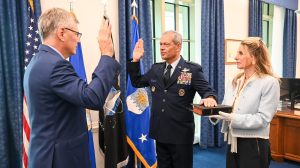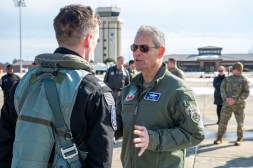‘Measure twice, cut once’ — Gen. Allvin takes cautious approach to changing Air Forces Cyber

When it comes to elevation and changes for the Air Force’s cyber component, the service’s top officer wants to make sure officials are meticulous in getting it right.
“AFCYBER is one of those … we want to make sure we measure twice and cut once because there’s different elements of that with respect to where the manpower belongs and … comes from different sources,” Gen. David Allvin, chief of Staff of the Air Force, told reporters at the Pentagon Friday.
In February, the Air Force announced a sweeping shakeup aimed at better organizing the department for a potential fight against China, which the Pentagon views as the “pacing threat.”
As part of that so-called reoptimization — which also includes a list of up to 24 changes to include reorganizations, shuffles and brand new commands — the decision was made to elevate Air Forces Cyber to a standalone service component command to reflect the importance of the cyber mission to the service and the joint force.
Details have been sparse since the announcement regarding exactly what an elevated Air Forces Cyber would look like.
Currently, Air Forces Cyber is part of 16th Air Force, an integrated information warfare command that was established in 2019, which sits beneath Air Combat Command. The elevation would remove it from that bureaucracy and put it directly under U.S. Cyber Command, in line with how other services have organized their service cyber components. This push is part of the Air Force’s wider plan to better organize its service components to combatant commands.
However, in addition to being the force generator for Cybercom — in which it provides 39 cyber mission force teams to conduct operations, with six additional teams the Air Force is building as part of authorized growth to the cyber mission force — 16th Air Force includes a variety of other information warfare capabilities and commands.
The organization includes cyber, electromagnetic spectrum operations, intelligence, surveillance, reconnaissance, information operations, weather as well as the service’s cryptologic component to the National Security Agency to provide an integrated information warfare organization — a move that was lauded back in 2019 given that adversaries were organizing their forces under an integrated information warfare framework.
One of the reasons it is taking so long to determine AFCYBER’s future, is the Air Force is trying to ensure it provides the right organization with the right forces to project power, which could mean taking out some of the forces from the current 16th Air Force.
“We want to make sure as we do that, those that are strictly internal — we make sure we have those resident in the other ISR wings — because there’s some things in 16th Air Force that are reconnaissance wings that aren’t necessarily on the cyber” side, Allvin said. “We are really looking how we do that exactly right, so we make sure that the Cyber Command commander gets what he or she needs, and we still have the resident capability within our Air Force to project power … We’re being very careful to ensure that we’re still meeting the combatant commander needs and still developing the cyber relationship.”
Allvin noted they are about 90 percent of the way there and will likely have more specifics in the next month or two, telling reporters that just this morning he had a virtual teleconference with the 16th Air Force commander and Cybercom commander, who is also an Air Force officer and was the inaugural 16th Air Force commander.
As the Air Force pushes ahead with its internal changes, Allvin noted that it will be reexamining what a major command, or MAJCOM, is within the service.
At the time the reoptmizaion plan was released, many outside commentators speculated that elevating Air Forces Cyber meant it would become a major command, like Air Combat Command.
Allvin noted the disjointed nature of major commands in the Air Force currently with three- and four-star major commands and entities that are also service components, such as Pacific Air Forces.
“There’ll be big service component commands — [United States Air Forces in Europe–Air Forces Africa], PACAF, huge. And there will be smaller ones. But they will all have the same relationship as a service component command to a combat command. So you know that’s what your Air Force looks like, not sort of things here or there,” he said, noting that part of the reorganization is making Air Force units easier to plug into joint combatant commands and for those combatant commanders to better understand those units.
“I don’t know if the term MAJCOM will eventually sort of fade away,” Allvin added.






